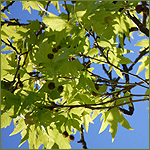An international team of researchers has developed a model that suggests degradation of tropical forests occurs in a series of “waves”, reports the BBC News website’s Mark Kinver.
 High-value trees were felled in the first “wave”, followed by a wave that removed mid-value timber before the remaining wood was felled for charcoal.
High-value trees were felled in the first “wave”, followed by a wave that removed mid-value timber before the remaining wood was felled for charcoal.
The team hopes the model will help manage forests as vital carbon sinks and limit the loss of biodiversity.
The findings appear in the Proceedings of the National Academy of Sciences.
The researchers said an economic theory was used to provide a general model to predict patterns of tree loss.
This translates to a prediction that waves of forest degradation will emanate from major demand centres and expand into nearby forested areas, targeting resources in sequence, starting with those of highest value,” they wrote in their PNAS paper.
“Such a sequence of demand, linked to resource utilisation, has been demonstrated for unmanaged fisheries… but has not been shown for the exploitation of differently valued tropical forest products.”
The team used data collected in the area surrounding Tanzania’s largest city, Dar es Salaam, to see how far the degradation “waves” had travelled between 1991 and 2005.
“The first wave that emanates is high-value timber, and that is mostly used for export,” explained co-author Antje Ahrends, an ecologist at the Royal Botanical Garden, Edinburgh.
“There has been a massive demand for this in China, and this is where most of the timber ends up.”
Dr Ahrends said the first wave moved out from Dar es Salaam rapidly, averaging about nine kilometres each year, because the “timber companies had lorries and loads of people working for them”.
“For the firms, it is only worthwhile to stay in a forest when timber can be accessed relatively easily,” she told BBC News.
“So once it becomes not so easy to get hold of the rest, the companies generally move on.”
The first wave had already moved outside of the team’s study area, and Dr Ahrends estimated that it was already more than 200km from Dar es Salaam.
The second wave saw trees being felled for medium-valued timber, which was generally used in the city for construction and furniture.
“This is expanding very rapidly, in line with urban migration,” she explained. “The town has an average growth rate of about 7% each year, so there is – again – a rapidly growing demand for this material.”
The timber is harvested by local companies, again with lorries, allowing large volumes to be collected in a relatively short space of time. This resulted in this degradation wave to also cover about nine kilometres each year.
The third and final wave involved local people collecting wood to make charcoal for cooking.
“It’s the most destructive of all of the waves because charcoal burners would collect everything,” observed Dr Ahrends, who was based at the York Institute for Tropical Ecosystem Dynamics when she carried out this research.
“It is only worthwhile moving on once there are no sizeable trees left in the forest.”
As a result, the charcoal wave had moved relatively slowly – from 20km outside Dar es Salaam in 1991 to 50km away in 2005.
“It is the most difficult of the waves to tackle because it is very poor people who burn charcoal and their livelihoods depend upon it.”
“Targeting that wave would mean trying to provide alternative resources for cooking, and alternative incomes for people who burn charcoal.
Species loss
The team also developed their model to gauge what impact forest degradation had on “public good” services, such as carbon storage and biodiversity.
They did this by recording what species of trees were in a particular area of the study, and what size the individual trees were.
“This later enabled us to calculate species richness and also the amount of carbon those trees were storing,” Dr Ahrends said.
“We found that there was a very strong linear impacts; for example, tree species richness dropped to only 14 species-per-sample-unit close to Dar es Salaam, whereas it is more than 40 species in areas 200km away.”
Dr Ahrends suggested that the model could be used to understand the impact of forest degradation in other sub-Sarahan nations in Africa.
“This is because conditions are very similar: high levels of corruption, weak law enforcement and very rapid rates of urbanisation.”
She added that the team’s model could help policymakers who were looking at ways to limit deforestation rates.
“What is really important is to understand the pattern of degradation and the way it spreads,” she suggested.
“While we have a good understanding of deforestation – which is the complete clearance of a forest – it is much more difficult to measure degradation.
“So if you have this simple model, then you have a basic understanding of how degradation might spread… which may help you develop some prediction of where it might spread from and how far it might spread.”
Source: BBC News website
Date: 03/08/2010
Filed under: conservation, deforestation, illegal logging, rainforest, research, tropical timber | Tagged: africa, biodiversity, burning, carbon, catprue, charcoal, degradation, environment, illegal logging, logging, pnas, research, royal botanical gaden edinburgh, science, sequestration, sub-saharan africa, tanzania, timber, tropical rainforests, value, waves, woodfuel, york university | Leave a comment »






 During extremely long periods of heat, however, this reduction enables the forests to continue their evaporation for longer, so the net effect is ultimately one of cooling in relation to the surroundings, explained a team of scientists led by Ryan Teuling from
During extremely long periods of heat, however, this reduction enables the forests to continue their evaporation for longer, so the net effect is ultimately one of cooling in relation to the surroundings, explained a team of scientists led by Ryan Teuling from